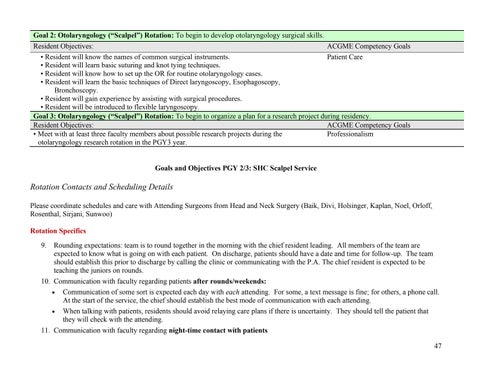Goal 2: Otolaryngology (“Scalpel”) Rotation: To begin to develop otolaryngology surgical skills. Resident Objectives: ACGME Competency Goals • Resident will know the names of common surgical instruments. Patient Care • Resident will learn basic suturing and knot tying techniques. • Resident will know how to set up the OR for routine otolaryngology cases. • Resident will learn the basic techniques of Direct laryngoscopy, Esophagoscopy, Bronchoscopy. • Resident will gain experience by assisting with surgical procedures. • Resident will be introduced to flexible laryngoscopy. Goal 3: Otolaryngology (“Scalpel”) Rotation: To begin to organize a plan for a research project during residency. Resident Objectives: ACGME Competency Goals • Meet with at least three faculty members about possible research projects during the Professionalism otolaryngology research rotation in the PGY3 year. Goals and Objectives PGY 2/3: SHC Scalpel Service
Rotation Contacts and Scheduling Details Please coordinate schedules and care with Attending Surgeons from Head and Neck Surgery (Baik, Divi, Holsinger, Kaplan, Noel, Orloff, Rosenthal, Sirjani, Sunwoo) Rotation Specifics 9.
Rounding expectations: team is to round together in the morning with the chief resident leading. All members of the team are expected to know what is going on with each patient. On discharge, patients should have a date and time for follow-up. The team should establish this prior to discharge by calling the clinic or communicating with the P.A. The chief resident is expected to be teaching the juniors on rounds.
10. Communication with faculty regarding patients after rounds/weekends: • Communication of some sort is expected each day with each attending. For some, a text message is fine; for others, a phone call. At the start of the service, the chief should establish the best mode of communication with each attending. • When talking with patients, residents should avoid relaying care plans if there is uncertainty. They should tell the patient that they will check with the attending. 11. Communication with faculty regarding night-time contact with patients 47




